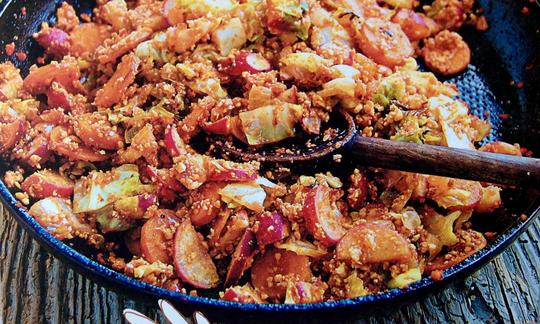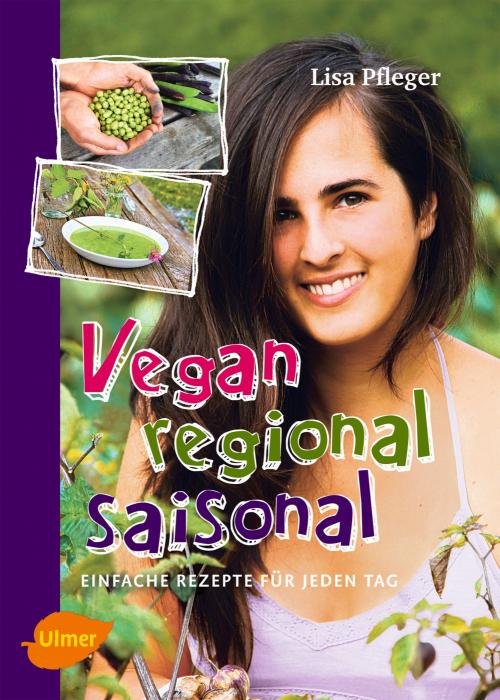Okara and Radish Stir-Fry with White Cabbage
vegan
Ingredients (for servings, )
| For the okara and radish stir-fry | |
|---|---|
| 1 | Onions, raw (organic?) (3.9 oz) |
| 2 | Carrots (carrots), raw (organic?) (4.3 oz) |
| 1 bunch | Radishes, raw (organic?) (8.1 oz) |
| 2 ½ cups | Okara (soy pulp, raw?, organic?) (11 oz) |
| 1 tbsp | Sunflower oil (cold pressed? raw? organic?) (0.48 oz) |
| 1 cup, chopped | White cabbage (white cabbage, raw cabbage, organic?) (3.1 oz) |
| 1 cup | Canned tomatoes (chopped, raw?, organic?) (8.5 oz) |
| Seasoning and garnish | |
| 1 dash | Table salt (table salt, raw?, organic?) (0.01 oz) |
| 1 tsp, ground | Oregano, dried (raw?, organic?) (0.06 oz) |
Equipment
- skillet (frying pan)
- stove
Type of preparation
- cook
- fry
- chop or grind
- season to taste
- sauté
- remove the skin
Preparation
For the okara and radish stir-fry
Peel and chop the onion, chop the carrots and radishes, and then set to the side.Fry the okara in hot oil. Then add the vegetables and diced tomatoes and continue to cook until the vegetables are ready.
Tomato sauce: The original recipe calls for tomato sauce, which the author prepares using fresh tomatoes, salt and, herbs of her choice (recipe on p. 26 of the cookbook “Vegan regional seasonal”). Alternatively, you can also use a ready-to-eat organic tomato sauce or even canned tomatoes. But if you have fresh tomatoes available, these are preferable.
Okara: If you have cooked okara, you can use it directly. However, if you have made your own soy milk, for example, and thus obtained unheated or "raw" okara, this should be cooked before consumption, just like soybeans. In various proven recipes, the authors give cooking or simmering times of around 20 minutes. One scientific study found an 80% reduction in certain nutrient-restricting components for soybeans when cooked for 20 minutes. Based on this information, we recommend a cooking time of around 20 minutes under exposure to greater heat.
Seasoning and garnish
At the end of the cooking process, season the Okara and Radish Stir-Fry with salt and sprinkle with herbs.At this point, Lisa Pfleger uses half a teaspoon of salt. Since the salt needed varies according to taste, we have deliberately listed just a pinch. You can add more if needed.
|
Nutritional Information per person
Convert per 100g
|
2000 kcal | |
|---|---|---|
| Energy | 294 kcal | 14.7% |
| Fat/Lipids | 10 g | 14.5% |
| Saturated Fats | 1.2 g | 5.8% |
| Carbohydrates (inc.dietary fiber) | 46 g | 16.9% |
| Sugars | 14 g | 15.7% |
| Fiber | 8.3 g | 33.1% |
| Protein/Albumin | 10.0 g | 19.9% |
| Cooking Salt (Na:413.7 mg) | 1'051 mg | 43.8% |
| Essential micronutrients with the highest proportions | per person | 2000 kcal | |
|---|---|---|---|
| Vit | Vitamin K | 56 µg | 75.0% |
| Vit | Vitamin A, as RAE | 526 µg | 66.0% |
| Elem | Potassium, K | 1'310 mg | 65.0% |
| Min | Copper, Cu | 0.65 mg | 65.0% |
| Vit | Vitamin C (ascorbic acid) | 52 mg | 65.0% |
| Vit | Vitamin B9, B11 (Folate, as the active form of folic acid) | 127 µg | 64.0% |
| Min | Manganese, Mn | 1.2 mg | 60.0% |
| Fat | Linoleic acid; LA; 18:2 omega-6 | 5.7 g | 57.0% |
| Sodium, Na | 414 mg | 52.0% | |
| Prot | Tryptophan (Trp, W) | 0.12 g | 50.0% |
Detailed Nutritional Information per Person for this Recipe
The majority of the nutritional information comes from the USDA (US Department of Agriculture). This means that the information for natural products is often incomplete or only given within broader categories, whereas in most cases products made from these have more complete information displayed.
If we take flaxseed, for example, the important essential amino acid ALA (omega-3) is only included in an overarching category whereas for flaxseed oil ALA is listed specifically. In time, we will be able to change this, but it will require a lot of work. An “i” appears behind ingredients that have been adjusted and an explanation appears when you hover over this symbol.
For Erb Muesli, the original calculations resulted in 48 % of the daily requirement of ALA — but with the correction, we see that the muesli actually covers >100 % of the necessary recommendation for the omega-3 fatty acid ALA. Our goal is to eventually be able to compare the nutritional value of our recipes with those that are used in conventional western lifestyles.
| Essential fatty acids | per person | 2000 kcal |
|---|---|---|
| Linoleic acid; LA; 18:2 omega-6 | 5.7 g | 57.0% |
| Alpha-Linolenic acid; ALA; 18:3 omega-3 | 0.19 g | 9.0% |
| Essential amino acids | per person | 2000 kcal |
|---|---|---|
| Tryptophan (Trp, W) | 0.12 g | 50.0% |
| Threonine (Thr, T, irreversibly transaminated) | 0.42 g | 45.0% |
| Isoleucine (Ile, I) | 0.38 g | 31.0% |
| Lysine (Lys, K, irreversibly transaminated) | 0.54 g | 29.0% |
| Phenylalanine (Phe, F) | 0.40 g | 26.0% |
| Valin (Val, V) | 0.41 g | 26.0% |
| Leucine (Leu, L) | 0.58 g | 24.0% |
| Methionine (Met, M) | 0.11 g | 12.0% |
| Vitamins | per person | 2000 kcal |
|---|---|---|
| Vitamin K | 56 µg | 75.0% |
| Vitamin A, as RAE | 526 µg | 66.0% |
| Vitamin C (ascorbic acid) | 52 mg | 65.0% |
| Vitamin B9, B11 (Folate, as the active form of folic acid) | 127 µg | 64.0% |
| Vitamin B6 (pyridoxine) | 0.65 mg | 47.0% |
| Vitamin E, as a-TEs | 5.0 mg | 41.0% |
| Vitamin B1 (Thiamine) | 0.23 mg | 21.0% |
| Vitamin B3 (Niacin) | 2.7 mg | 17.0% |
| Vitamin B5 (Pantothenic acid) | 1.00 mg | 17.0% |
| Vitamin B2 (Riboflavin) | 0.21 mg | 15.0% |
| Vitamin B7 (Biotin, ex vitamin H) | 7.1 µg | 14.0% |
| Essential macroelements (macronutrients) | per person | 2000 kcal |
|---|---|---|
| Potassium, K | 1'310 mg | 65.0% |
| Sodium, Na | 414 mg | 52.0% |
| Calcium, Ca | 257 mg | 32.0% |
| Phosphorus, P | 203 mg | 29.0% |
| Magnesium, Mg | 96 mg | 26.0% |
| Essential trace elements (micronutrients) | per person | 2000 kcal |
|---|---|---|
| Copper, Cu | 0.65 mg | 65.0% |
| Manganese, Mn | 1.2 mg | 60.0% |
| Iron, Fe | 4.8 mg | 34.0% |
| Selenium, Se | 18 µg | 33.0% |
| Zinc, Zn | 1.8 mg | 18.0% |
| Iod, I (Jod, J) | 3.1 µg | 2.0% |
| Fluorine, F | 9.9 µg | < 0.1% |
In this book "Vegan regional seasonal" beginners in vegan cooking will find valuable tips and inspiration.
Since this book is written in German, a description is omitted here. If you are interested, please switch to German in the menu.
You can use okara, a by-product of the soy milk production, to conjure up this stir-fry, a dish that goes well with a piece or two of fresh, crunchy bread.
Unit of measurement (cups): The “cups” used in this recipe refer to a cup with a volume of 250 ml.
Okara: Okara is the pulp of soybeans, a by-product of soy milk production with a neutral taste. You can find a recipe to make okara yourself on page 26 of the cookbook “Vegan regional saisonal.” In cooking, it is used as an ingredient for pastry dough, soups, and casseroles, and is also added to muesli. Since okara is a good binder, it can be used as an egg substitute. Okara is rich in starch, protein, fiber, and iron. In an air-tight container, it can be stored in the refrigerator for about a week — and dried in crumb form for several weeks.
If you have cooked okara, you can use it directly. However, if you have made your own soy milk, for example, and thus obtained unheated or "raw" okara, this should be cooked before consumption, just like soybeans. In various proven recipes, the authors give cooking or simmering times of around 20 minutes. One scientific study found an 80% reduction in certain nutrient-restricting components for soybeans when cooked for 20 minutes. Based on this information, we recommend a cooking time of around 20 minutes under exposure to greater heat.
Making okara yourself: Under the ingredient “Okara,” you will find directions on how to make okara yourself in five steps. If you want to use homemade okara in this recipe, you should soak the soybeans in water overnight before starting.
Possible combinations: This okara and radish stir-fry goes well with rice or crunchy bread.
Tomato sauce: You can prepare tomato sauce easily by cooking tomatoes and then chopping or pureeing them. There is a recipe for homemade tomato sauce in the cookbook "Vegan regional seasonal" on page 26. Alternatively you can use our recipe: Tomato Sauce with Tamarind. If you are in a hurry or don’t have fresh tomatoes on hand, you can also use store-bought organic tomato sauce or diced tomatoes in a can.
Seasoning with herbs: Along with oregano, you can also use other Mediterranean herbs such as basil, rosemary, or thyme. Depending on which type of tomato sauce you use, you may not have to use any additional seasoning at all.




